Spring 2024
Using Nature to Control Pests
by Robin Mitchell
All creatures have a role to perform in the delicate dance of nature.
Spring is such a wonderful time of the year, and it is a good time to look for beneficial insects as the plants and flowers begin to emerge and bloom. These beneficial insects can help control unwanted pest insects, so that other methods, such as chemicals, are not needed.
Beneficial insects are like a silent army in the complex ecosystem of your garden that work nonstop to keep pests away from your plants. These unsung heroes don't carry traps or pesticides like you might anticipate from a traditional rescue. Rather, these beneficial insects serve as natural predators, controlling the number of dangerous insects and maintaining the delicate equilibrium in your garden.
For example, it is always exciting to find lady beetles, in all their life cycle stages (egg, larva, pupa, adult), because they are such beneficial insects for controlling aphids. Ladybugs are probably the most adored of all beneficial insects because of their vivid colors and delicate look. But don't be fooled by their adorable appearance; these little beetles are ferocious predators that eat mealybugs, aphids, and other soft-bodied pests that damage your plants. A ladybug is a useful ally in the battle against garden pests, especially aphids.
Here is what lady beetle eggs look like:

The image below shows the larval stage. Important to know is that ladybugs are the most ferocious aphid predators during the larval stage. Their appearance is so different from the adult stage, as shown in the photo above. If you didn’t know that the larval stage was a predator of aphids, you might think it is a pest and destroy it, which you don’t want to do! Be on the lookout for them in your garden.

Here is the pupa stage, where the larva is turning into an adult. Again, it might look like an insect you don’t want in your garden, but you actually should want to protect it to make sure that the adult can emerge!
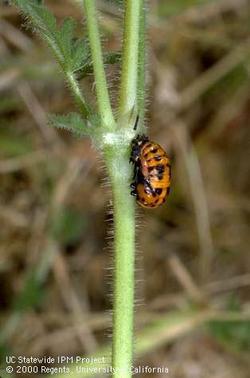
And finally, the familiar form of the adult lady beetle emerges from the pupa.
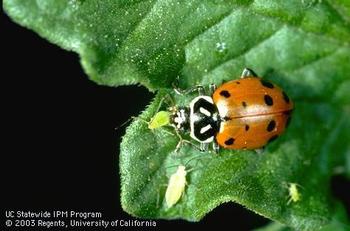
Continuing with the example of controlling aphids, which can be a serious pest problem in vegetable gardens, there are many beneficial insects that can be used to control them, which include:
- Convergent Lady Beetle (the larvae and adult stages)
- Lacewings
- Syrphid fly larvae
- Soldier beetles
- Tiny parasitic wasps (they turn aphids into crusty “mummies”)
Because the larvae of many beneficial insects are some of the most voracious predators of pests, it is important to be able to identify them so that you don’t mistake them for pests and remove them!
If you provide food and habitat for these beneficial insects, they will be naturally attracted to your garden and they will want to stay and help you manage pest problems.
These beneficial insects are supported by many flowering plants that can also be used as herbs or cut flowers, including baby’s breath, California lilac, California poppy, English thyme, Italian oregano, sweet alyssum, tansy phacelia, and white yarrow. Many of the flowering plants can have additional purposes such as being used as herbs (Thyme, Oregano, …) and cut flowers, as well as increasing pollination of the vegetables by pollinators such as bees. And they make a beautiful addition to your garden!
Using natural predators, such as the lady beetle, to control pests is part of the practice of Integrated Pest Management (IPM). IPM is defined as “an ecosystem-based strategy for long-term prevention of pests or their damage” using a combination of the following techniques:
- Biological control
Techniques that use natural enemies to control pests and their damage, such as using lady beetles to control aphids. - Cultural controls
Practices that reduce the establishment of the pest, or make the environment unsuitable for it. For example, changing irrigation practices can reduce pest problems, since too much water can increase root disease and weeds. - Mechanical and physical controls
Controls that kill a pest directly, block the pest out, or make the environment unsuitable for it. Examples include:- Trapping rodents
- Mulching for weed management
- Steam sterilization of the soil for disease management
- Building barriers such as screens to keep birds or insects out
- Chemical control
Controls that use pesticides. This final control is used only when the other techniques have failed, and is generally used in combination with the other approaches for more effective, long-term control. Following IPM practices, the most selective pesticide is used that will do the job and be the safest for other organisms and for air, soil, and water quality. For example, the pesticides would be contained in bait stations or spot-sprayed on a few weeds instead of an entire area.
The diagram below illustrates the principles of IPM nicely, showing that biological control (such as using beneficial insects) is the large base of the pyramid and the most benign control method, while chemical control is the small top of the pyramid (used as little as possible) and the most toxic.
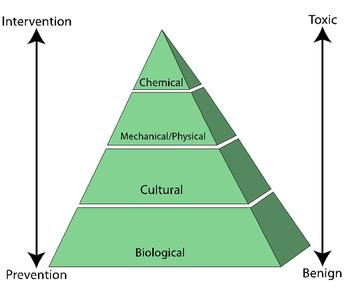
There are six major components that are common to all IPM programs:
- Pest identification
- Monitoring and assessing pest numbers and damage
- Guidelines for when management action is needed
- Preventing pest problems
- Using a combination of biological, cultural, physical/mechanical, and chemical management tools
- After action is taken, assessing the effect of pest management
Step 2, monitoring and assessing the pest numbers and damage, is critical so that only necessary management controls.
Many of the pests in a garden are small organisms such as insects, mites, snails and slugs. Many of these pests can be very effectively managed using biological and cultural controls, as discussed at the beginning of the article “The Top 20 Garden Problems”.
Important to remember is that the variety of helpful predators in your garden is evidence of the resilience of the natural world. You may lessen the need for hazardous pesticides and chemical interventions while enhancing the long-term health and vigor of your plants by cultivating a healthy ecology that supports these natural companions. So, the next time you see a beneficial insect in your garden, stop and consider the important function they play in maintaining the health and safety of your plants.
Examples of plants that support beneficial insects:

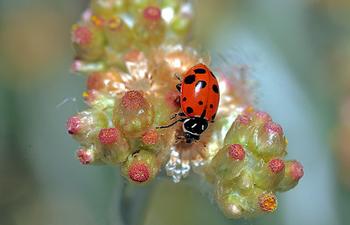

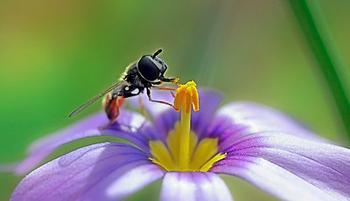

Resources:
- What is IPM?
https://ipm.ucanr.edu/what-is-ipm/ - Beneficial Predators Quick reference
https://ipm.ucanr.edu/QT/beneficialpredatorscard.html - Natural enemies gallery, Listed by Common Name - UC Statewide IPM Program
- Natural Enemies Handbook: The Illustrated Guide to Biological Pest Control
- Flower Flies (Syrphidae) and Other Biological Control Agents for Aphids in Vegetable Crops
https://anrcatalog.ucanr.edu/pdf/8285.pdf - Hedgerow benefits align with food production and sustainability goals
More Quicktips:
- Beneficial Predators--UC IPM
- Lady Beetles--UC IPM
- Garden Chemicals: Safe Use & Disposal--UC IPM
- Meet the Beneficials: Natural Enemies of Garden Pests
(downloadable poster)- Here is a direct link to a PDF of the poster: Poster-Beneficials
- Parasites of insect pests
https://ipm.ucanr.edu/QT/parasitesinsectcard.html - Less toxic insecticides
https://ipm.ucanr.edu/QT/lesstoxicinsecticidescard.html - UC Berkeley Urban Bee Lab
- Best Bee Plants for California
Many of the plants that are attractive to bees will also be attractive to beneficial insects.
- Best Bee Plants for California
Ordering publications:
- Vegetable Pest Identification for Gardens and Small Farms - ANR Catalog
(53 cards $18.75 on sale)
